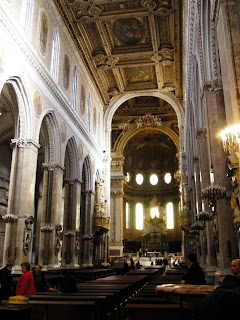With final exams also around the corner, I didn't have much to time do anything else but focus on school and figuring how I was going to get all my things back home in a non-hazardous manner.
I was able to schedule one afternoon to travel to Siena prior to leaving. Siena is only one train ride from Florence, and would definitely be doable. I figured if I didn't take this time to travel there now, I'd never get the chance.
Soon after school dismissed, I jetted to the train station once more. I hopped on the next train to Siena. Upon arriving, a million signs were directing me to the main piazza of the city, Piazza Del Campo. With many other travelers also wanting to arrive at the same destination, we all marched towards the main sight. You could sense Christmas was approaching...
Piazza Del Campo turned out to a surprisingly different square, designed in a quite intriguing way. It's shaped like a semi-circle.
The square used to be a local marketplace for Sienese citizens, but today plays host to a famous biannual horse racing event, the Palio.
The design of the piazza is incredibly imaginative, leading towards Palazzo Pubblico, the local town hall. The huge clock tower is humongously tall, making sure you always know the time of day.
I grabbed lunch at a local pizzeria within Piazza Del Campo and observed the local scene. It was a relatively pleasant afternoon for Siena.
Afterwards, I proceeded to visit Siena's central fort. The museum within houses many local antiquities and numerous paintings related to Sienese culture.
This tree was plated in glowing gold:
The figure below is actually carved entirely from wood. To think it actually started from a mere block of wood!
Imagine what ancient secrets lay within the confines of these locked treasures:
I spiraled to the top of the fort, which provided the best view of Siena. It was sublime.
The viewpoints of Italy never get old, they always seem to dazzle. There's something very natural and absorbing about the Tuscan landscape that's not apparent in any other region. It's a mixture of history, nature, and tranquility. I find it hard sometimes translating the exact impression. I guess one has to experience it themselves to properly understand what I mean.
I next visited the Cathedral of Siena, one the main attractions of the city. Built during the 13th century, Siena's Dumo is a classic example of Italian Medieval architecture.
When German composer Richard Wagner visited Siena in the summer of 1880, the effect of the Cathedral of Siena had quite impact on him. It brought him to tears, and thus subsequently utilized its design for the Grail Temple in his famed opera, "Parsifal."
Many interesting and fascinating works lay within, including sculptures by Donatello.
Reflecting on the interior of the cathedral, I'm finding trouble properly distinguishing its unique characteristics. Not necessarily because it's a bland locale, but since I visited so many churches throughout Italy, they all now seem like one gargantuan church to my fish memory.
Some the pictures I took re-captured my experience within:
Siena's sense of pace is quite serene. It doesn't run on the busy nature of bigger cities, but maintains a very quiet, yet eloquent atmosphere. I appreciate the flavor, but I'm not sure if could seriously live in Siena. At least not now, maybe when I grow a few more grey hairs.
































